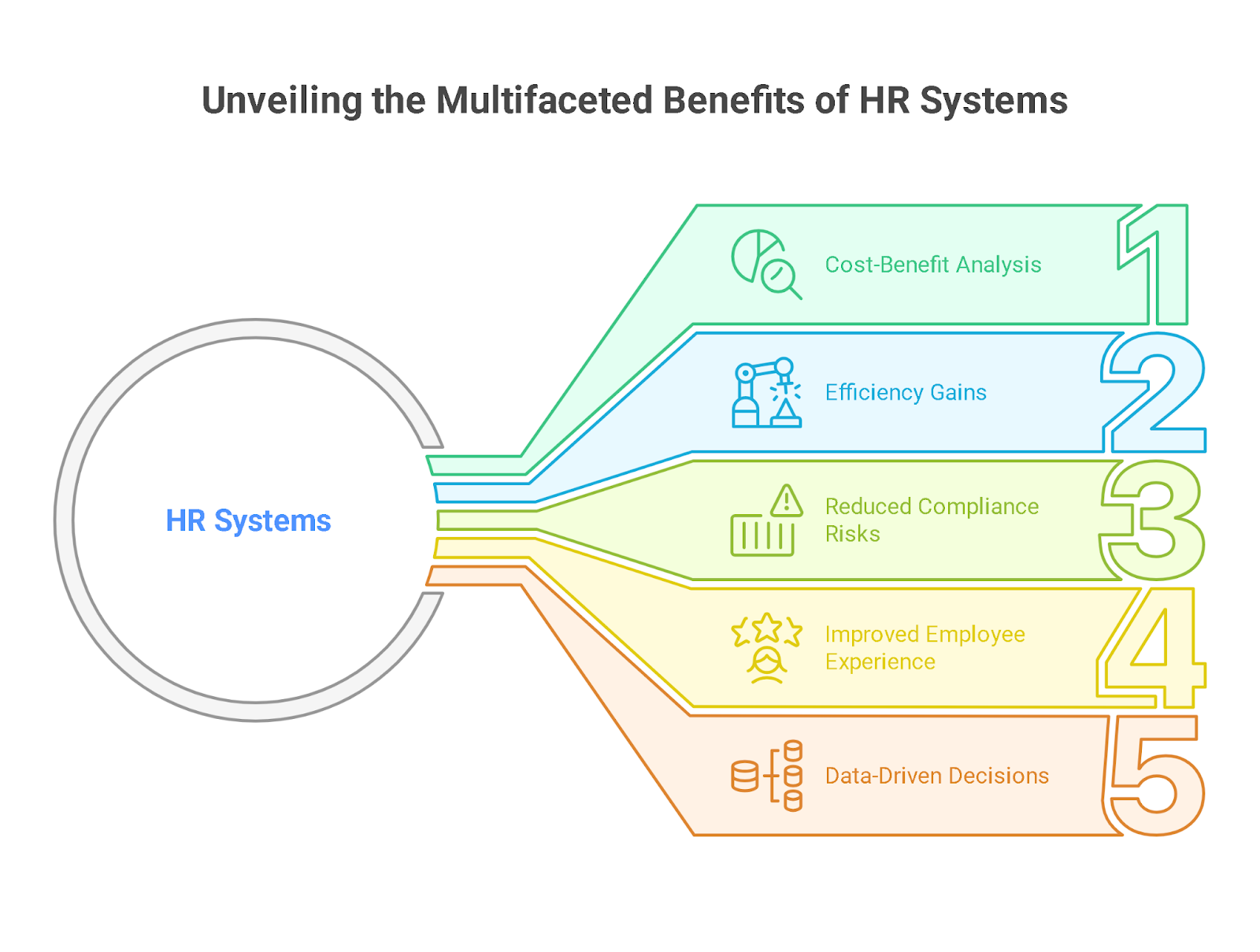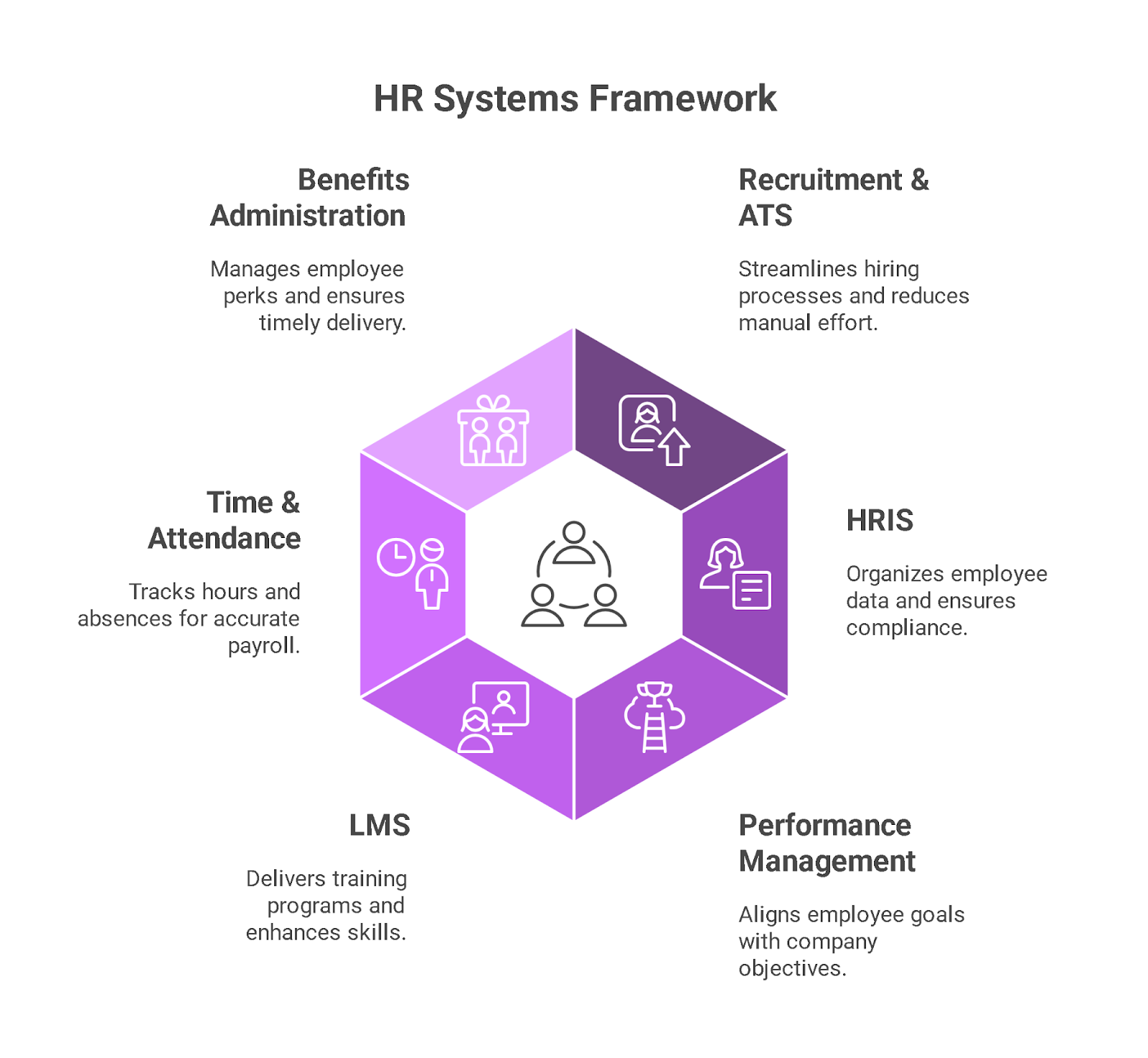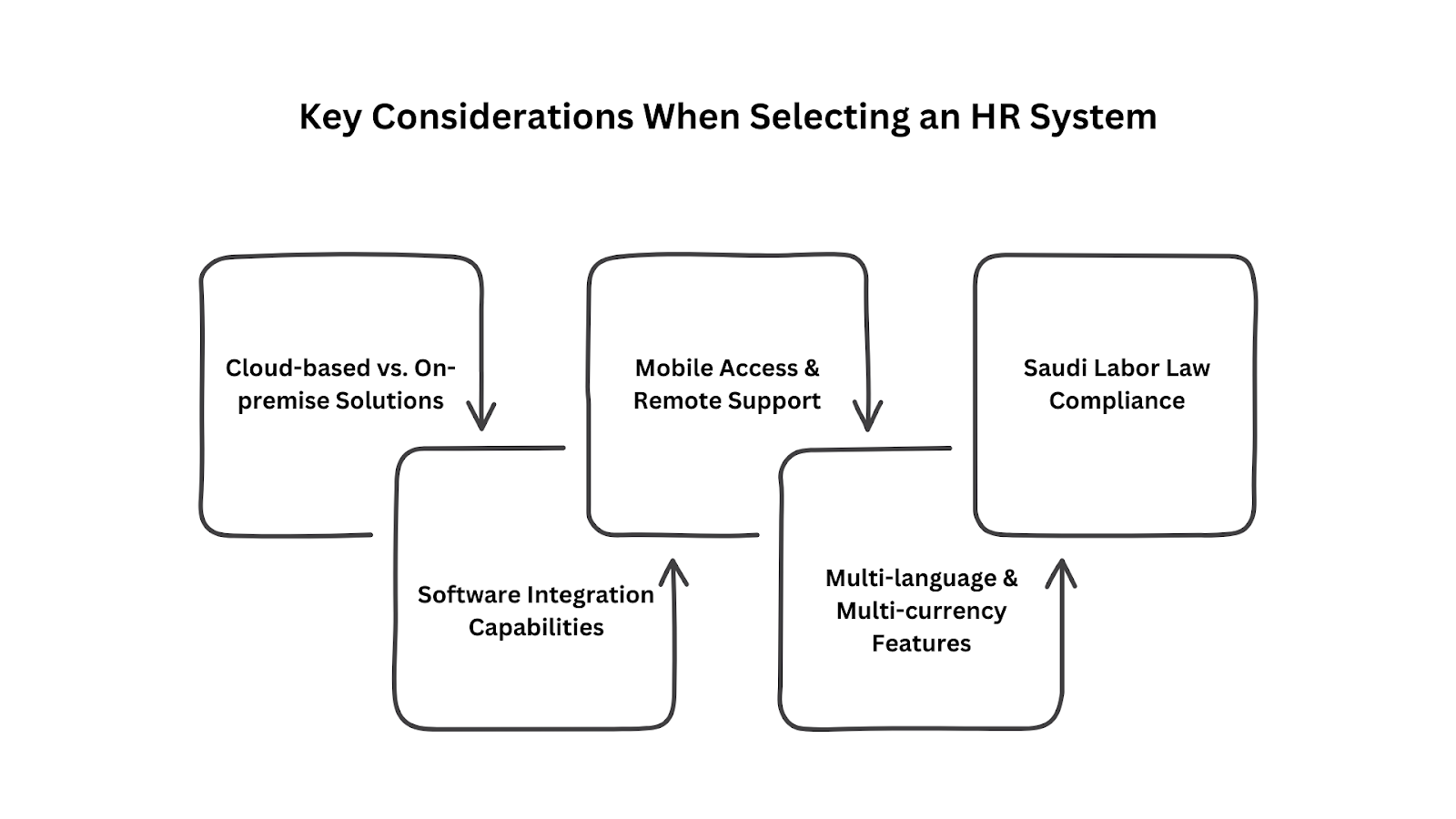.jpg)
هل تواجه صعوبة في السيطرة على مهام الموارد البشرية مع نمو عملك؟ عندما تصبح مهام التوظيف، والرواتب، وإدارة الموظفين عبئًا، فإن ذلك يؤثر على إنتاجية فريقك ويبطئ من وتيرة اتخاذ القرارات.
بالنسبة للشركات المتوسطة في قطاعات المقاولات، والتجارة، والتجزئة، والتصنيع، والخدمات في المملكة العربية السعودية، يُعد هذا تحديًا شائعًا.
اختيار أنظمة الموارد البشرية المناسبة يمكن أن يبسط هذه المهام ويساعدك على التركيز على ما هو أهم: تنمية عملك.
تماشيًا مع رؤية المملكة 2030، التي تركز على التحول الرقمي والتحديث، يُعد اعتماد التقنية المناسبة في الموارد البشرية أمرًا أساسيًا للبقاء في موقع تنافسي في بيئة أعمال تتغير بسرعة.
يُبسّط هذا الدليل مفهوم أنظمة الموارد البشرية، ويُظهر كيف توفر الوقت، وتقلل الأخطاء، وتساعدك على التحكم بعملياتك.
دعنا نستعرض أولاً كيف يمكن للنظام المناسب في الموارد البشرية أن يفتح آفاق النمو ويُحسّن من كفاءة عملياتك.
برنامج الموارد البشرية هو حل رقمي يساعد الشركات على إدارة مهام الموارد البشرية مثل إدارة بيانات الموظفين، والرواتب، وتتبع الحضور، والتوظيف — وكل ذلك من خلال منصة مركزية واحدة.
يقوم بأتمتة العمليات الروتينية في الموارد البشرية، مما يُلغي الحاجة إلى الجداول الإلكترونية والمعاملات الورقية، ويُقلل بشكل كبير من الأخطاء.
ومع دخولنا عام 2025، أصبح برنامج الموارد البشرية أكثر أهمية من أي وقت مضى. بيئة العمل أصبحت رقمية ولا مركزية بشكل متزايد، حيث تتجه العديد من الشركات إلى نماذج العمل عن بُعد أو الهجين. هذا التحول يجعل من الضروري أن تمتلك الشركات أنظمة فعالة لإدارة وتتبع معلومات الموظفين بأمان، بغض النظر عن موقعهم.
تتصدّر المملكة العربية السعودية هذا المجال إقليميًا. فقد جعلت المبادرات الحكومية الداعمة للتحول الرقمي والاستثمارات التقنية المتزايدة برامج الموارد البشرية عنصرًا أساسيًا للشركات المتوسطة.
لنبسّط الفكرة من خلال سيناريو توضيحي:
تعرّف على سارة، مديرة الموارد البشرية في شركة تصنيع نامية بالرياض. تقضي ساعات في التوفيق بين سجلات الموظفين، وحساب الرواتب، وأوراق التوظيف. تقع أخطاء، ويضيع الوقت.
برنامج الموارد البشرية يُغيّر كل ذلك؛ فهو يُنظّم بيانات الموظفين، ويُؤتمت الرواتب، ويتتبع الحضور، ويدعم عمليات التوظيف، مما يُتيح لسارة التركيز على الأعمال الاستراتيجية.
اقرأ أيضًا: 5 أسباب تجعل عملك بحاجة إلى برنامج موارد بشرية وكشوف رواتب
الآن بعد أن فهمنا الفوائد، دعنا نلقي نظرة على الأنظمة الستة للموارد البشرية التي يمكن أن تؤثر بشكل مباشر على عملك.
تُقدَّر سوق تقنيات الموارد البشرية في المملكة العربية السعودية بـ1.3 مليار دولار أمريكي، مدفوعة بالتحول الرقمي في البلاد وتماشياً مع رؤية 2030. ومع تبني الشركات لتقنيات الموارد البشرية مثل برامج التوظيف، وأنظمة الرواتب، وتحليلات القوى العاملة، تتزايد الحاجة إلى حلول تعزز الكفاءة والامتثال.

إليك كيف توفّر أنظمة الموارد البشرية قيمة ملموسة للمؤسسات الصغيرة والمتوسطة:
تختلف تكلفة برامج الموارد البشرية حسب حجم الشركة. بالنسبة للشركات المتوسطة، فإن الاستثمار في حلول شاملة غالبًا ما يؤدي إلى عائد استثماري كبير من خلال تقليل العمل اليدوي وتحسين الكفاءة التشغيلية. يكمن فهم العائد على الاستثمار في مقارنة رسوم التراخيص وتكاليف التنفيذ والدعم المستمر بالوقت الموفر وانخفاض معدل الأخطاء.
ملاحظة: تأكد من احتساب تكلفة الامتثال لأنظمة العمل السعودية ومتطلبات هيئة الزكاة والضريبة والجمارك، حيث إن عدم الامتثال قد يؤدي إلى غرامات كبيرة.
تقوم أنظمة الموارد البشرية بأتمتة المهام مثل معالجة الرواتب وتتبع الحضور، مما يتيح لفِرق الموارد البشرية التركيز على الأهداف الاستراتيجية.
على سبيل المثال، يمكن لشركة تصنيع أن تقلل وقت معالجة الرواتب بنسبة 50%، مما يحسّن الإنتاجية ويسرّع من إجراءات نهاية الشهر.
تساعد أنظمة الموارد البشرية في ضمان الامتثال من خلال تحديث اللوائح بشكل مستمر وأتمتة حسابات المزايا. وهذا يقلل من خطر الغرامات الناتجة عن عدم الامتثال والأخطاء في الرواتب.
على سبيل المثال، يمكن لشركة تجارية أن تتجنب المشكلات القانونية باستخدام نظام يُنبه إلى ثغرات الامتثال قبل أن تتحول إلى مشكلة.
توفر أنظمة الموارد البشرية بوابات للخدمة الذاتية تتيح للموظفين تقديم طلبات الإجازات، والوصول إلى كشوف الرواتب، والتسجيل في الدورات التدريبية، مما يعزز رضاهم الوظيفي.
ومن خلال تبسيط هذه العمليات، يمكن للشركات تقليل معدل دوران الموظفين.
على سبيل المثال، قد تشهد شركة تجزئة معدلات احتفاظ أعلى بالموظفين بفضل زيادة الشفافية وتسريع معالجة الرواتب.
توفّر أنظمة الموارد البشرية الحديثة لوحات تحكم تحليلية لمتابعة مؤشرات مثل معدلات دوران الموظفين ومقاييس الأداء.
يمكن لقادة الأعمال الاستفادة من البيانات الفعلية لاتخاذ قرارات مدروسة، مثل معالجة فجوات المهارات بشكل استباقي أو التنبؤ باحتياجات التوظيف بدقة أكبر.
ومع معرفة هذه الأنظمة، من المهم النظر في العوامل التي ستوجهك لاختيار النظام الأنسب لعملك.
تأتي أنظمة إدارة الموارد البشرية بأشكال متعددة؛ فبعضها يركز على وظيفة محددة، بينما يوفر البعض الآخر مجموعة واسعة من الخدمات المتكاملة.
فيما يلي 6 أنواع شائعة من أنظمة إدارة الموارد البشرية، إلى جانب أبرز الميزات التي تقدمها:

يقلل هذا النظام من العمل اليدوي ويُسرّع من وتيرة التوظيف، وهو أمر بالغ الأهمية للشركات المتوسطة التي تواجه نقصًا في المواهب أو معدلات دوران عالية.
الميزات الرئيسية:
الفوائد:
يُعد برنامج HRIS مركزًا رئيسيًا لتخزين وإدارة بيانات الموظفين، حيث يُبقي السجلات منظمة وسهلة الوصول، مما يقلل الأخطاء ويُسهّل إعداد التقارير والامتثال للمتطلبات التنظيمية.
بالنسبة للشركات السعودية المتوسطة، يدعم HRIS إدارة فعّالة للقوى العاملة والامتثال لأنظمة العمل المحلية.
الميزات الرئيسية:
الفوائد:
تعمل برامج إدارة الأداء على تتبع أهداف الموظفين، والتغذية الراجعة، والتقييمات، مما يُمكّن من تحقيق نمو منظم ومسؤولية واضحة.
بالنسبة للشركات في السعودية، تساعد هذه الأنظمة في مواءمة جهود الموظفين مع الأهداف الاستراتيجية، وتعزز الإنتاجية والمشاركة.
الميزات الرئيسية:
الفوائد:
توفر منصات إدارة التعلم (LMS) برامج تدريب وتطوير منظّمة، وهي ضرورية لتأهيل الموظفين وتدريبهم على متطلبات الامتثال.
تستفيد الشركات السعودية من هذه الأنظمة لتلبية متطلبات السعودة وتحسين كفاءة القوى العاملة دون التأثير على سير العمل.
الميزات الرئيسية:
الفوائد:
تقوم برامج إدارة الوقت والحضور بتسجيل ساعات عمل الموظفين، وتتبع الغيابات، وإدارة جداول الورديات.
ويُعد التتبع الدقيق ضروريًا في المملكة العربية السعودية للامتثال لأنظمة العمل والتحكم في تكاليف العمالة.
الميزات الرئيسية:
الفوائد:
يقوم برنامج إدارة المزايا الوظيفية بإدارة الامتيازات المقدمة للموظفين مثل التأمين الصحي، البدلات، ومكافأة نهاية الخدمة.
بالنسبة للشركات في السعودية، يُسهّل هذا البرنامج إدارة المزايا ويحسّن التواصل بشأنها مع الموظفين.
الميزات الرئيسية:
الفوائد:

اختيار نظام الموارد البشرية المناسب يتطلب مراعاة عدة عوامل قد تؤثر على كفاءة عملك وامتثاله للأنظمة. فيما يلي خمسة مجالات رئيسية يجب على الشركات المتوسطة في المملكة العربية السعودية أخذها بعين الاعتبار قبل اتخاذ القرار:
قد توفّر أنظمة الموارد البشرية السحابية مرونة أكبر وتكلفة مبدئية أقل من خلال استضافة البيانات عن بُعد.
على سبيل المثال، قد تستفيد شركة تجزئة مقرها الرياض ولديها عدة فروع من إمكانية تحديث سجلات الموظفين فورًا عبر جميع المواقع دون الحاجة إلى موارد تقنية معقدة.
ومع ذلك، من الضروري التأكد من أن مراكز بيانات المزوّد تتوافق مع متطلبات الإقامة المحلية للبيانات وفقًا لتوجيهات وزارة الاتصالات وتقنية المعلومات (MCIT).
أما الحلول المحلية (On-premise)، فقد توفّر تحكمًا أكبر في البيانات، لكنها غالبًا ما تتطلب استثمارًا أوليًا أكبر وصيانة مستمرة.
قد تفضّل الشركات التي تتبع سياسات صارمة لحماية البيانات هذا الخيار.
وبالنظر إلى تركيز المملكة على حماية البيانات، فإن الموازنة الدقيقة بين هذين الخيارين تُعد خطوة حاسمة.
قد يحتاج نظام الموارد البشرية لديك إلى التكامل بسلاسة مع أنظمة تخطيط الموارد المؤسسية (ERP)، أو المحاسبة، أو كشوف الرواتب.
على سبيل المثال، قد تواجه شركة مقاولات في جدة مشكلات إذا كانت فرق الموارد البشرية والمالية تستخدم أدوات منفصلة، مما يؤدي إلى إدخال البيانات بشكل مكرر ووقوع أخطاء.
ابحث عن حلول تحتوي على تكامل مثبت مع منصات مثل سداد، مدد، ومنصة الفوترة الإلكترونية الخاصة بهيئة الزكاة والضريبة والجمارك (ZATCA).
يساهم نظام الموارد البشرية المتكامل بشكل فعّال في تقليل العمل اليدوي، وتحسين اتساق البيانات، وتعزيز الكفاءة العامة.
3. الوصول عبر الهاتف المحمول ودعم العمل عن بُعد
مع تزايد اعتماد العمل عن بُعد في المملكة العربية السعودية، أصبحت أنظمة الموارد البشرية المتوافقة مع الهواتف المحمولة ضرورية أكثر من أي وقت مضى.
فالشركات الخدمية، على سبيل المثال، قد يكون لديها موظفون ميدانيون يعتمدون على هواتفهم الذكية لتسجيل الحضور وتقديم طلبات الإجازة.
يوفّر الوصول عبر الهاتف المحمول للموظفين القدرة على إدارة المهام المتعلقة بالموارد البشرية في أي وقت ومن أي مكان، مما يعزز التفاعل والرضا الوظيفي، ويقلل من التأخيرات الإدارية.
تتميّز القوى العاملة في المملكة العربية السعودية بتعدد الثقافات واللغات، والتعامل مع عملات مختلفة.
على سبيل المثال، قد تستفيد شركة تجارية في الرياض من برنامج موارد بشرية يدعم واجهات باللغة العربية والإنجليزية والهندية، ويُتيح دفع الرواتب بالريال السعودي وعملات أخرى حسب الحاجة.
ابحث عن حلول تدعم أيضًا تقارير نظام حماية الأجور (WPS) بصيغة الريال السعودي، وفق تنسيق منصة "مدد".
مثل هذه الميزات تُعزّز من قابلية الاستخدام لدى الموظفين، وتُسهّل إدارة التعويضات بدقة وامتثال كامل.
الامتثال يُعد أمرًا بالغ الأهمية. فقد يحتاج نظام الموارد البشرية لديك إلى مساعدتك في الالتزام بأنظمة العمل السعودية ولوائح ضريبة القيمة المضافة تحت إشراف هيئة الزكاة والضريبة والجمارك (ZATCA).
على سبيل المثال، قد تحتاج شركة تصنيع في المدينة المنورة إلى تحديثات تلقائية لاحتساب الضرائب واحتساب مكافآت نهاية الخدمة.
تأكّد من أن النظام قادر على توليد تقارير بصيغ متوافقة مع متطلبات تدقيق ZATCA والتأمينات الاجتماعية (GOSI).
تساعد ميزات الامتثال في تقليل المخاطر القانونية وتبسيط عمليات التدقيق.
اقرأ أيضًا: هل نظام إدارة الموارد البشرية لديك متوافق مع نظام العمل السعودي المُحدّث؟
فهم عوامل التنفيذ يساعدنا على إدراك الأثر الحقيقي لأنظمة الموارد البشرية على نمو الأعمال.
وأخيرًا، دعنا نستعرض لماذا غالبًا ما تتفوق حلول ERP المتكاملة مع الموارد البشرية على البرامج المنفصلة في الشركات النامية.
إذا كنت تدير شركة متوسطة في المملكة العربية السعودية، فقد تكون تفكّر في المفاضلة بين برنامج موارد بشرية مستقل، أو نظام ERP متكامل يتضمّن وظائف الموارد البشرية.
غالبًا ما تقتصر أدوات الموارد البشرية المنفصلة على الأساسيات مثل كشوف الرواتب والتوظيف، لكنها لا تتكامل مباشرة مع أنظمة المالية أو العمليات، مما يؤدي إلى عمل يدوي، وأخطاء، وتأخيرات.
مثال واقعي:
شركة Jash Holding، إحدى الشركات الرائدة في إدارة المرافق في السعودية، تضم أكثر من 4,000 موظف في مواقع متعددة.
كانت تعاني من أنظمة قديمة يصعب توسعتها وتُبطئ العمليات.
إدارة بيانات الموظفين، والرواتب، وتكاليف المشاريع، والامتثال لضريبة القيمة المضافة يدويًا كان يستغرق وقتًا طويلاً ويشكّل خطرًا على الامتثال والدقة.
الحل:
تدخلت HAL ERP عبر وحدة موارد بشرية (HRMS) مصممة خصيصًا، قامت بتبسيط عمليات التوظيف، والرواتب، وإدارة العقود، مع تكامل سلس مع أنظمة إدارة المشاريع والمالية.
النتائج:
شهادة من ماثيو جورج – المدير المالي في Jash Holding:
“نحن نستخدم HAL منذ 2020، ونحن سعداء جدًا به. يلبّي جميع احتياجاتنا التشغيلية، ويقلل من ساعات العمل في عدة مجالات. حلّ HAL العديد من مشاكلنا، مثل إدارة رواتب 3000 موظف، وأكثر من 12000 أصل ومخزون. أصبح بإمكاننا رؤية جميع تكاليف الموظف في شاشة واحدة، مثل الراتب والتكاليف المرتبطة به. الدعم باللغتين العربية والإنجليزية رائع أيضًا.”
الخلاصة:
الأنظمة المتكاملة مثل HAL ERP تُحدث فرقًا حقيقيًا في بيئة الشركات المتوسطة، خصوصًا في السوق السعودي المتسارع رقميًا. إنها لا تكتفي بإدارة الموارد البشرية، بل تُنسّق بينها وبين العمليات والمحاسبة والمشاريع، لتوفّر وقتك وتحمي عملك من المخاطر التشغيلية والتنظيمية.
[احصل على دراسة الحالة الكاملة]
اقرأ أيضًا: تعزيز كفاءة القوى العاملة: القوة التحولية لنظام HAL ERP
طوال هذا الدليل، استعرضنا أنظمة الموارد البشرية الرئيسية للشركات السعودية المتوسطة—من التوظيف والرواتب إلى إدارة الأداء والمزايا. يساعد كل نظام في تبسيط مهام الموارد البشرية وضمان الامتثال للقوانين المحلية. كما أوضحنا كيف تربط حلول ERP المتكاملة الموارد البشرية بالمالية والعمليات، مما يعزّز الكفاءة ويسرّع عملية اتخاذ القرار.
فهم الخيارات المتاحة هو الخطوة الأولى. والقيمة الحقيقية تكمن في اختيار النظام المناسب لنمو وتعقيد عملك.
يوفر HAL ERP حلاً متكاملاً للموارد البشرية مصممًا خصيصًا لقطاعات المقاولات، والتصنيع، والتجارة، والتجزئة، والخدمات. تشمل مميزاته:
هل أنت مستعد للانتقال إلى ما بعد العمليات المبعثرة للموارد البشرية؟ اكتشف كيف يمكن لنظام HAL ERP المتكامل أن يحوّل إدارة القوى العاملة ويدعم أهداف عملك.
تواصل مع HAL ERP اليوم لاكتشاف طريقة أذكى لإدارة الموارد البشرية وتسريع النمو. اطلب عرضًا تجريبيًا مخصصًا لقطاعك واحتياجات الامتثال لديك.